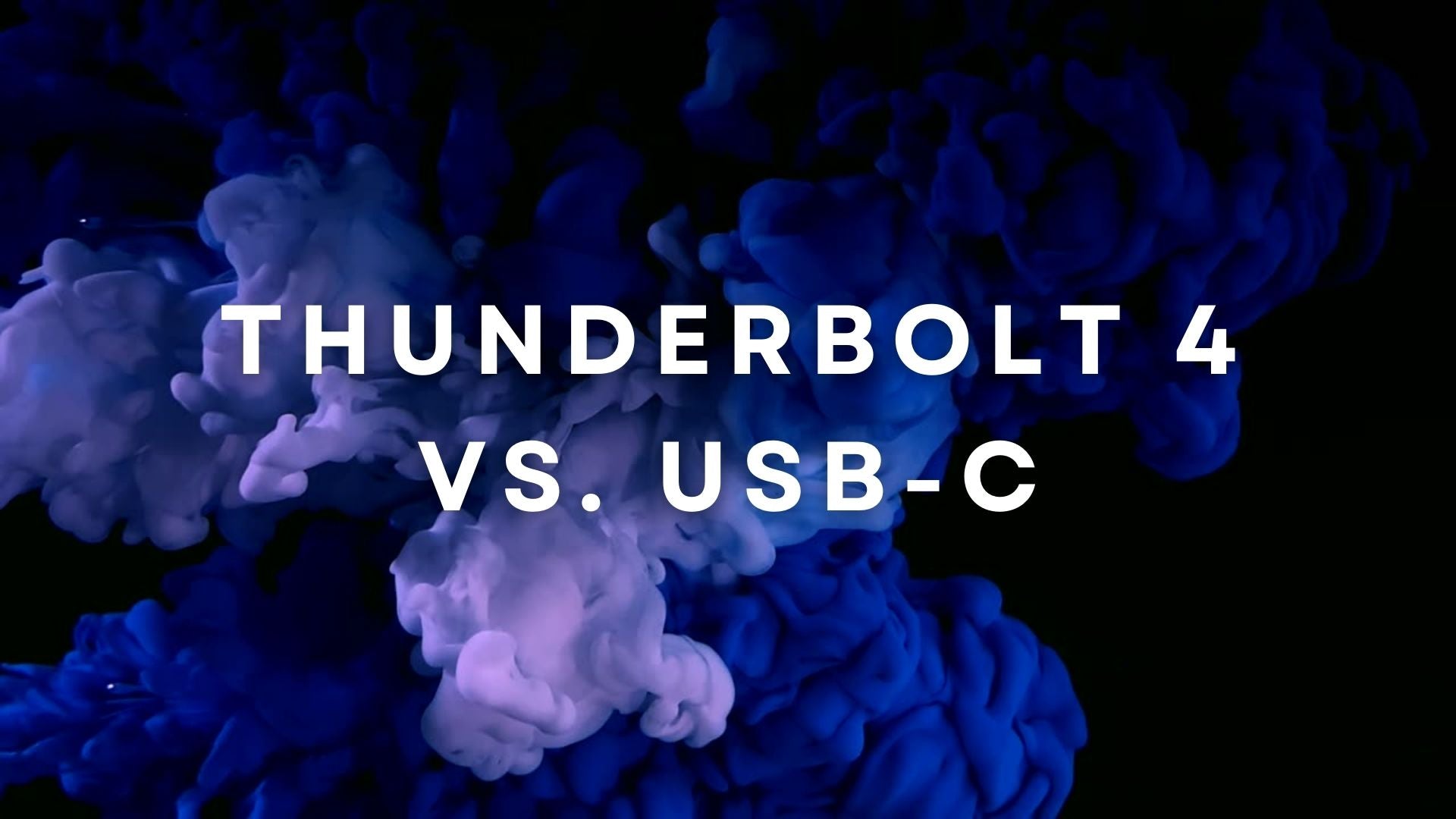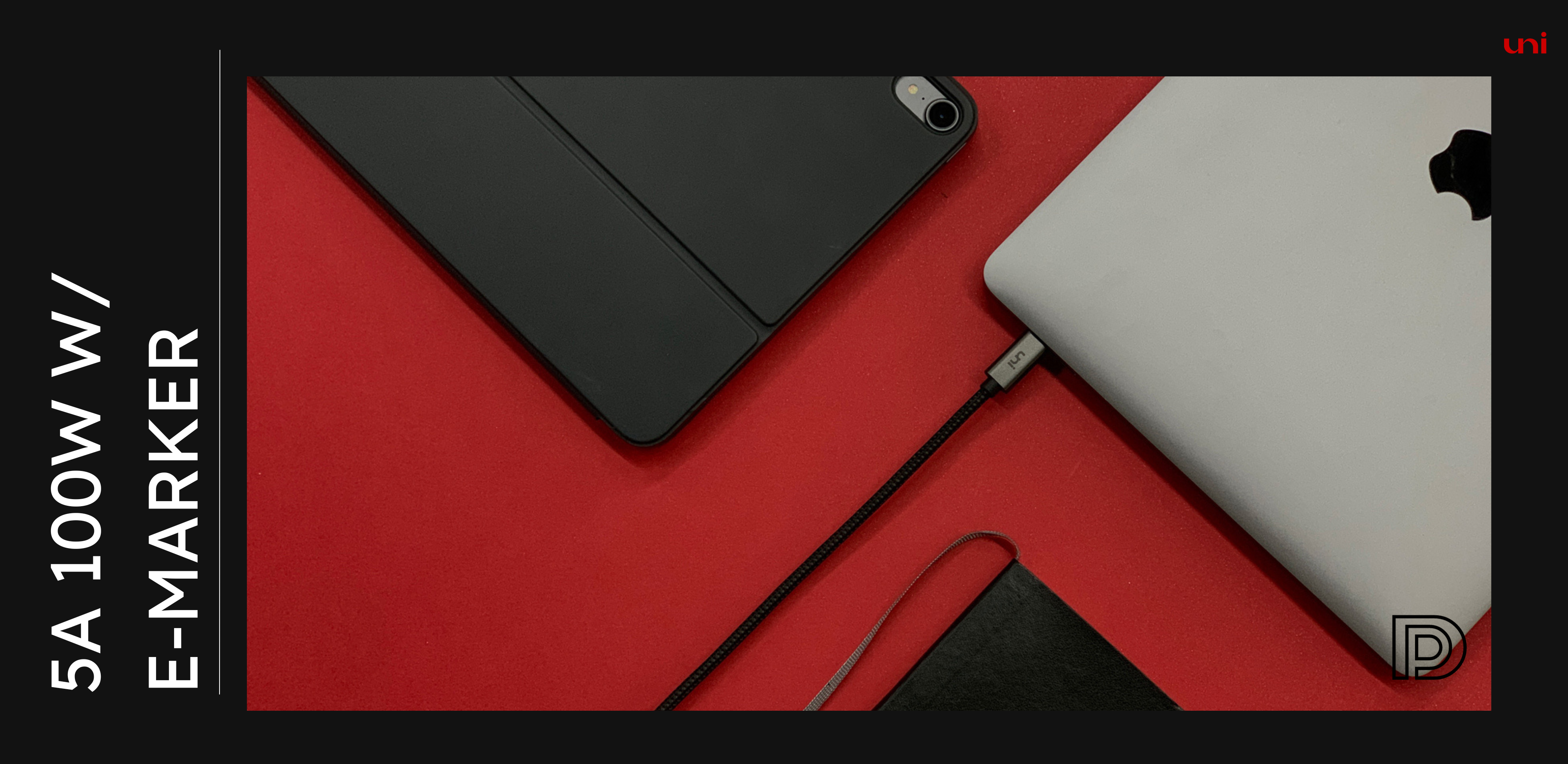Thunderbolt 4 vs. USB-C: A Straightforward Comparison
October 30, 2023 10 min read
The unending tug of war,Thunderbolt vs. USB-C, is finally settling. There seems to be a tie in favor of both. Back then, Thunderbolt and USB standards used to be like two distant cousins who didn't really get along. It caused a lot of confusion and, honestly, a fair share of frustration when dealing with ports, plugs, and cables. You'd often find yourself asking questions like,"Can I use this cable to power up my laptop? And what about connecting my phone?" It was like a puzzle we all had to solve and wasn't always straightforward.
This brief is laser-targeted to show the difference between Thunderbolt 4 and USB-C, their limitations, and five questions that most people ask.

Thunderbolt 4 Vs. USB-C: Dissection
Thunderbolt 4 and USB-C are outcomes of tech innovators' year-long struggle to bring unification in connectivity systems. Both are unique yet part and parcel of modern laptops, tablets, external hard drives, and graphics cards. They handshake together, permitting you to have external displays while successfully operating your peripherals through a dock or hub. Without them, you wouldn't conceive an ambient working space free of cables messing around your table.
But how did USB-C and Thunderbolt 4 come closer?
Let's explore the Mariana Trench of hidden information.
What is USB-C or Type-C?
USB-C is a one-stop solution for power anddata-hungry devices. Interestingly, it sends and receives data and electricity using one single cable. And it does this simultaneously. Unlike its ancestors, USB-A and USB-B, Type-C is easy to pluginandout. As it has a symmetrical shape, you can insert it without worrying about the potential damage to your port or connector. Known for its ability to deliver fast data transfer speeds and power up to 100 Watts, making it suitable for various devices from smartphones to laptops. Its user-friendly design aims to become the universal standard, replacing older USB variants.
Although the 'U' of USB stands for Universal, it had never been so. However, USB-C is posturing to become the ultimate universal connector. What makes me maintain this stance unequivocally?
Well, inch-by-inch USB-C is absorbing DisplayPort and Thunderbolt, allowing these technologies to run over it. It supportsUSB 3.2 (Gen 2×2) and the cutting-edgeUSB V2, Thunderbolt 4, and Next Gen Thunderbolt. EvenApple, the torch bearer of Thunderbolt, is now dropping its 12-year-old relationship "lightning port" into USB-C in its next release,iPhone 15.
How is that shift happening?
You might think that USB-C may have some technological edge that Thunderbolt no longer carries. If you know the answer, don't read;first comment below. Let's test your knowledge.

Image Credit: Whatmobile
What is Thunderbolt 4?
Thunderbolt 4 is the outcome of fast-paced advancement within the Thunderbolt protocol. The Thunderbolt technology offers the following vital benefits:
- Higherbandwidth to meet the need for high-speed devices
- Reliable connection between your device and PC
- Easyexpansion of your PC's capabilities through docking station and external devices
- Enhanced I/O ( commonly pronounced eye-oh) operations for gaming setup
A Thunderbolt 4 provides a solution to three major problems. It delivers high-speeddata transfer, pushesvideo-out signal, and throwspower at the same time. But that’s not it. Thunderbolt 4 is more than a port. It has dynamic bandwidth.
Bandwidth of Thunderbolt 4
It has a dynamic bidirectional bandwidth of40 Gbps. That means data can swiftly oscillate from external storage, and you can connect as many as five Thunderbolt devices to a single port. The phrase “as many as five” has a deeper meaning. The following example will further simplifies it.
For example, you could connect a Thunderbolt 4 docking station to your laptop using a single Thunderbolt 4 port. Then, you can attach multiple devices like external drives, monitors, and other peripherals through the docking station. The"as many as five" limit means you can mix and match these devices as long as the total number doesn't exceed five. Even more exciting is that all your dock-connected peripherals wake your PCfrom hibernation.
What's discussed is just a trailer of what amazing Thunderbolt 4 offers. More exciting advantages are listed below.
But don't you want to learn thefundamental difference between Thunderbolt and USB-C?
Thunderbolt 4 and USB-C: What Sets Them Apart?
USB-C and Thunderbolt 4 are as different as apples are from oranges. USB-C is a connector capable of carrying large amounts of data and power. On the other hand, Thunderbolt is a protocol, a standard interface. The following illustration adds more simplicity to it.
ImagineUSB-C as a road and Thunderbolt 4 as ahigh-performance car. USB-C provides the infrastructure with various entry and exit points, like intersections on the road, allowing different devices to connect. However, just as a well-paved road is essential for a car's smooth journey, USB-C ensures a reliable pathway for Thunderbolt 4 devices to operate at peak performance. USB-C acts as the road on which Thunderbolt 4 cars can travel efficiently. In short, the TB 4 port fits the standard USB-C connector.
Remember that Thunderbolt 4 isn't the only version of Thunderbolt technology that utilizes USB-C. Its predecessor, the Thunderbolt 3, also uses the USB-C connector.
Thunderbolt 4, Thunderbolt 3, and USB-C: Comparison
Notable differences between Thunderbolt 4, Thunderbolt 3, and USB-C are listed below:
Data Transfer Speed:
- Thunderbolt 4 and 3 offer a maximum data transfer rate of 40 Gbps
- The speed of USB-C varies from 20 Gbps (USB 3.2 Gen ) to 80 Gbps ( USB4 2.0)
Power Delivery (PD):
- Thunderbolt 4/ 3 supports up to 100W of power delivery for charging.
- The range of USB-C power delivery varies according to the USB version installed in the port, but you can expect between 15W and 240W.
Compatibility:
- Thunderbolt 4 and 3 are backward compatible with Thunderbolt 2, USB 4, and USB-C.
- USB-C is Universally compatible with various USB standards, and Thunderbolt (if supported)
Daisy Chaining
- Thunderbolt 4 and Thunderbolt 3 enable daisy-chaining of multiple Thunderbolt devices.
- USB-C is not typically designed for daisy-chaining unless it carries a Thunderbolt 3 or 4 interface.
Docks Or Hubs
- Thunderbolt 3/4 Hubs are Compatible with both USB-C and Thunderbolt 3/4 devices, offering multiple connectivity options such as USB ports, Ethernet, audio jack, and display output.
- USB-C Dock is Primarily designed for Type-C devices and peripherals with partial compatibility for Thunderbolt devices.
· The following Image gives a birds-eye view of some distinctive and overlapping features of Thunderbolt 4, Thunderbolt 3, and USB-C.
|
Features |
Thunderbolt 4 |
Thunderbolt 3 |
USB-C |
|
Data Transfer Speed |
40 Gbps |
40 Gbps |
480 Mbps to 20 Gbps |
|
Power Delivery |
Up to 100W |
Up to 100W |
15W to 240W |
|
Compatibility |
Backward compatible |
Backward compatible |
Universally compatible |
|
Daisy-Chaining |
Yes |
Yes |
Typically not designed for it |
|
Monitors/ Displays |
Two 4K displays or one 8K |
Two 4K displays or one 5K |
Varies in resolution/refresh |
|
Accessories/Peripherals |
Thunderbolt-specific |
Thunderbolt and USB-C |
USB peripherals and accessories |
|
Host Device Support |
Newer laptops/desktops |
Past few years laptops/ |
Ubiquitous on modern devices |
|
Cost |
Typically premium |
Mid-range to high-end |
Varies widely |
Indeed, Thunderbolt 4 and USB-C are magnificent means to digitalize the world. Yet, their usage can be tricky sometimes.
Limitations of Thunderbolt 4 and USB-C
While USB-C and Thunderbolt 4 offer various benefits, they have inherent limitations.
Limitations of Thunderbolt 4
- While Thunderbolt 4 is versatile, not all devices support this technology, leaving you to purchaseadapters or specialized devices for older peripherals.
- Thunderbolt 4 devices, especially docks, and external graphics enclosures, can be relativelyexpensive compared to standard USB peripherals.
- To fully utilize Thunderbolt 4, you need acomputer with Thunderbolt 4 support, which may limit its accessibility for some users.
- Not all computers come with Thunderbolt 4 ports. So, finding compatible systems may requirespecific hardware choices: selecting laptops, workstations, or peripherals optimized for tasks such as video editing, gaming, or high-performance computing.
- Using multiple high-power devices simultaneously through Thunderbolt 4 may strainpower resources, especially on laptops with limited battery capacity.
Limitations of USB-C
- The USB-C standard hasmultiple versions (USB 3.1, USB 3.2, USB 4, etc.), and it can be confusing to determine which version a device supports and what speeds it offers.
- There is no agreed-upon set of rules regarding USB-C performance: Some USB-C ports on a laptop may support faster data transfer speeds or higher power delivery than another USB-C port on a different laptop.
- High-quality USB-C cables cancost more than old USB cables, and low-cost, inferior chords might not perform consistently.
- Users who switch to USB-C frequently need to buy extradongles and adapters to connect outdated devices, which can be difficult and expensive.
- Since not all USB-C ports support the same power delivery standards,charging speeds can vary from device to device.
When we weigh the benefits against these limitations, it becomes clear that the advantages of USB-C far outweigh any limitations. UBS-C makes your old gadget relevant with day-to-day advancement, and Uni is always at your back, pushing you to keep going against the tides of progress.
Uni’s USB-C to USB-A, Lightening, DisplayPort, and HDMI Cable
Picture this:USB-C, the all-in-one cable, is a trusty sidekick for your gadgets. It's that one cable that turns your laptop or phone into a versatile superhero, ready to tackle any task.
· Want to see your work on the big screen? USB-C to HDMI is a must-have.
· USB-C to DisplayPort unveils a world of vibrant visuals if you're a creative soul.
These excellent cables are just the tip of the burg; Uni has more exciting solutions to all your dailytech needs.
Thunderbolt 4 vs. USB-C: What People Mostly Ask
⏺ Why Thunderbolt Docking Station or Hub is Expensive?
Lastly, the number and types of ports, likeEthernet, HDMI, USB-C, and Thunderbolt, greatly impact how much something costs regarding functionality. Innovative features like Thunderbolt 4's high-speed data transmission capabilities further call for tricky engineering and certifications, skyrocketing the cost of manufacture.
⏺ Is Thunderbolt a Preferable Choice Compared to USB-C?
USB-C cables provide asweet spot for most users as they accept many peripherals and offer reasonable data transfer speed and charging options. At the same time, USB-C may not be a good choice if you aim to connect multiple monitors and transfer lots of data.
A Thunderbolt connection is more viable if you need todaisy-chain several 4K monitors or plan to transfer significant amounts of data. Since Thunderbolt 3 / 4 transfers40 Gbps of data, it can be the best partner to assist with large data transfers, especially when backing up your local storage.
⏺ Is Thunderbolt 4 Faster Than USB-C?
USB-C itself is not defined by specific data transfer speeds; instead, it refers to the physical connector shape and design. USB-C can support various data transfer speeds depending on the USB (USB 3.1, USB 3.2, USB4, USB V2) or Thunderbolt (3 or 4) standard it's paired with.
For instance, a USB-C connector paired withUSB 3.2 can provide data transfer speeds of up to 20 gigabits per second (Gbps), while a USB-C connector paired with Thunderbolt 4can achieve even faster speeds of up to 40 gigabits per second (Gbps).
⏺ What devices use USB-C?
Many manufacturers employing various operating systems (Android, Mac OS, and Windows) use USB-C in their products. That means USB-C has a wide range of presence.
Computers: Many modern laptops and desktops have USB-C ports for connecting monitors, peripherals, and power adapters. Among these are Apple's MacBook1, Chromebook models 2, and high-end computers with Thunderbolt 3 ports.
Mobile devices: Several smartphones and tablets use USB-C to charge and transfer data. Hence, you will find USB-C in Samsung, Google, Motorola, OnePlus, Sony, Insignia, and OtterBox. As noted earlier, Apple (with iPhone 15) will join the league.
Headphones: In recent years, a noticeable shift in headphone technology has seen some models eschewing the traditional 3.5 mm audio jack in favor of USB-C connectors. USB-C headphones transmit audio digitally and deliver cleaner sound with minimal interference.
Beyond audio, USB-C headphones often incorporate extra features like noise cancellation or integrated digital-to-analog converters (DACs) for superior sound processing. Lastly, the reversible design of USB-C connectors ensures a user-friendly, frustration-free connection process.
Flash Drives: Some flash drives come with USB-C and USB-A connectors, making them the best of both worlds. You can stay relevant with your old and advanced gadgets with such drives.
Image Credit : Amazon
Power banks:USB-C ports are fresh air for our gadgets. More and more smartphones, laptops, and even our beloved wireless earbuds are using it for speedy charging and heavy data transfers. Modern USB-C power banks can deliver a quick 5 volts/3 amps, which means your devices get juiced up in no time.
Thunderbolt 4 vs. USB-C: Final Words From Uni
Thunderbolt 4 and USB-C are like two old friends who've finally found common ground. They've put an end to the confusion and frustration we used to face with different ports and cables. It's clear that Thunderbolt 4 is a high-speed sports car, and USB-C is the well-paved road it runs on.
With its universal charm, USB-C is soaking up technologies like DisplayPort and Thunderbolt, becoming the ultimate connector.
Meanwhile, Thunderbolt 4 offers lightning-fast data transfer, power delivery, and more, making it a powerhouse. But they're not without their quirks. Thunderbolt 4 can be pricey and may not work with all devices. USB-C comes in various versions, which is confusing. Yet, the benefits far outweigh these limitations.
So, whether you're team Thunderbolt or team USB-C, both have made our digital lives simpler and more efficient, ensuring we're always ready to conquer any tech task.
Curious about Apple's switch to USB-C? Share your Email for the latest tech insights and updates. Join us on the path to the future of connectivity.
Leave a comment
Comments will be approved before showing up.
Also in Blog
How to Distinguish Low-Quality Electronic Waste on E-Commerce Platforms in 2025
March 19, 2025 3 min read
With the rise of online shopping, distinguishing between high-quality electronics and low-quality e-waste has become a critical skill. Many e-commerce platforms are flooded with questionable products that look appealing but often have serious quality and longevity issues.

Maximizing Your Internet Speed: The Ultimate Guide to Using a USB-C to Ethernet Adapter
July 12, 2024 4 min read
Read More Related Products
Recent Articles
- How to Distinguish Low-Quality Electronic Waste on E-Commerce Platforms in 2025 March 19, 2025
- Maximizing Your Internet Speed: The Ultimate Guide to Using a USB-C to Ethernet Adapter July 12, 2024
- How to Identify if a Device Supports UHS-II or UHS-I Protocols? June 24, 2024
- How to Use a USB-C Hub? Everything You Need to Know May 28, 2024
- Do I need a type c hub? What do you need to know before buying? April 12, 2024
- Can I Get 4k With USB-C to HDMI Cable or Hub? January 15, 2024
- Which USB-C Hub Should You Get? (Checklist) January 08, 2024
- Does USB-C Over Ethernet Work To Get Speedier Internet? January 01, 2024
- DisplayPort Over USB Type-C: The DP Alt Mode in Working December 27, 2023
- How to make Android phone Charge Faster (technician advice) December 11, 2023




